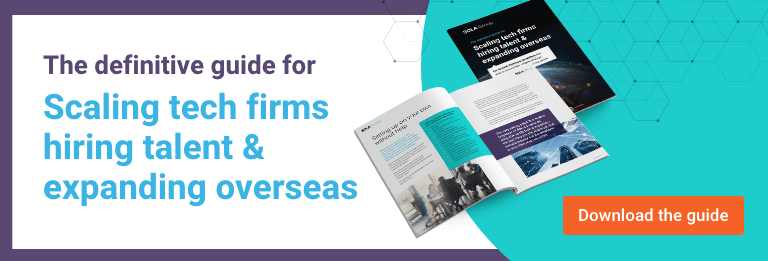Alexander the Great might have transformed international trade through bloody conquest, but US tech companies’ methods of international expansion are far less barbaric. However, expanding overseas is still inherently a risky business—and one that benefits from having an extension of your own team fighting on your side abroad.
The old way of global expansion
Professional Employer Organisations (PEOs) and Employers of Record (EoRs) were designed in the 1960s in the United States to help companies hire employees across state lines. More recently, companies looking to expand overseas have used a global version of these models (with an array of acronyms) to hire employees in different countries and comply with foreign regulations. However, these models have not evolved at the pace the modern world demands.
Although traditional EoR or PEO solutions (as well as the various other models) seem like a straightforward option for global expansion, using their services can potentially put companies at risk and land them in serious financial and legal trouble.
They are a way to outsource a specific problem—a lack of knowledge about the target jurisdiction—but there are essential pitfalls to the models that may leave your company vulnerable when you most need protection.
The vital areas that leave you exposed are due to:
- Weak protection from legal proceedings
- No way to safeguard Intellectual Property
- The co-employment contract model
- No continuity of employment
What is the new way to expand internationally?
In an alternative model, an overseas partner could set up a “virtual subsidiary” for you that enables that partner to be the sole employer of your new overseas employees, with the legal rights to control, direct, supervise, and manage them.
In this model, the partner also establishes a contractual trust that holds your overseas capital (IP, human resource capital, etc.) with you as the beneficiary. The legal infrastructure in this model removes the problematic issues that exist in PEOs and EoRs and protects you from the risks inherent in those offerings in three critical areas.
1. Protection from legal proceedings
Through the virtual subsidiary structure, the provider partner is the sole employer of the overseas employees with full rights to control, direct, supervise, and manage them. This distinction is crucial to protect you from local employment law obligations that arise from the PEO/EoR models.
To illustrate, a worker in France, co-employed by you and a PEO, could sue you for the misconduct of PEO personnel or unfair dismissal or similar. Though your PEO partner should be the true object of the claim, you could also be targeted by the French authorities and subject to French employment law and the French legal system, which is notoriously hostile to foreign companies appearing before them.
Additionally, with an EoR/PEO-model, client companies can be held liable for vicarious liability if their overseas employee commits an offence. Foreign legal systems would view both you and your partner as legally responsible for the actions of those employees.
Co-employment and shared responsibility provide a pathway to a joint legal obligation in the eyes of the foreign authorities. The protection you thought you had through your agreement with your PEO/EoR provider is, in fact, non-existent in other jurisdictions.
However, the legal structure of the virtual subsidiary model we are describing prevents these scenarios by being the sole and complete legal employer. The partner assumes all the risk for you, protecting you from unexpected liabilities.
2. Safeguarded Intellectual Property
New intellectual property created by employees during normal day-to-day activities should be your property. That is how it works with your direct employees in your home market. However, because co-employment or shared responsibility of the overseas employees creates legal ambiguity in those foreign jurisdictions, the true owner of that IP is uncertain. Do both you and your partner provider own it? How does that work legally and practically? Does that uncertainty undermine your contractual and financial value in the eyes of your investors?
Furthermore, under these shared-responsibility models, it is unlikely that you can legally grant valid permission for those overseas employees to access and work on your original current IP (things like source code, sales presentation, contact databases, etc.). Practically speaking, overseas employees cannot work with or on your assets. With PEOs and EoRs, the ownership of work done by shared international employees is legally in doubt.
Technology companies especially rely on the sanctity of their intellectual property to underpin the value of their offer to the customers they work with and the markets in which they work. Anything that threatens the validity of that IP threatens their business model as they expand globally.
But the virtual subsidiary and contractual trust model eliminates all those issues. Via the legal infrastructure of the trust, you have constant and instantaneous ownership of all IP created by workers employed by the virtual subsidiary. There is no question, legally or practically, about who owns the product of those overseas employees.
3. No risky co-responsibility ambiguity
Co-employment contracts make PEOs legally part employers of your overseas staff. And the shared responsibility model that EoRs operate has a similar effect in the eyes of foreign employment law. As we’ve seen above, this gives the providers rights (with IP, for example) and exposes you to unexpected legal risk.
When it comes time to open your own entity in the foreign jurisdiction, you will undoubtedly want to transfer the employees across with all their accrued benefits and service time. After all, they have been working for you for many years and have been important in developing your overseas business. Not providing this continuity of employment will risk alienating employees, potentially prompting them to leave.
With PEO and EoR models, continuity of employment is not possible. However, with the virtual subsidiary model, your provider partner is the sole employer making the compliant transfer (under the Transfer of Undertakings Directive in Europe, for example) of employees from them to you not only possible but seamless.
What about finding the right talent to help your global expansion?
The right global expansion solution should also have:
- Executive Search capabilities with specialist tech-sector expertise and extensive local talent networks
- Cultural understanding and sensitivity
Instead of relying on cold recruitment methods or multiple recruitment agencies, global expansion can benefit from specialist consultants.
These professionals should have deep knowledge of local employment landscapes and know extensive networks of top local talent. If they do not know the correct person for the job, they should rely on their experience to tirelessly search competitors for the right candidate.
Having a partner in the target jurisdiction benefits you as it can be difficult to attract talent for a company with no local history. However, with a partner abroad that understands its culture and that of the target jurisdiction, it is easier to find a candidate who shares the US-based company’s core values and vision.
The consultant will also be able to entice talent in a familiar language—cultural compatibility should be the foundation of any solid relationship.
A bespoke solution for an expanding tech company
Companies looking to expand abroad have traditionally had three options:
- Learn the rules of every target jurisdiction
- Open an entity and enter into a co-employment contract with a PEO
- Use an EoR that does not provide legal protection
Traditional PEO and EoRs were designed in a different era—but we are now in a vastly different world. In addition to being legally risky, they do not provide the level of service that expanding tech companies need. Employees under the administration of PEOs and EoRs often complain of the poor employee experience as they are not responsive and use one-size-fits-all and archaic methods. These solutions also appear cheaper at first, but they usually do not include added extras that can quickly add up—resulting in a costly final price.
No two expansion requirements are the same—and the answer shouldn’t be either. Expanding tech companies need a solution tailored precisely to their needs. The final price should be agreed upon at the beginning, and the level of service provided should be appropriate for a company in the tech sector.
Lastly, a partner expansion solution is only a temporary one. Most companies expanding overseas will be ready to open their own entity in about three years. However, until that point, saving time, money, and hassle is probably the main priority as growth is the main focus.
A virtual subsidiary with locally compliant employment contracts, assistance in hiring top local talent, and legal protection will allow you to do exactly that.


